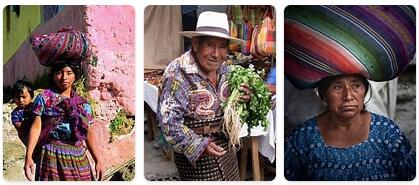
Yearbook 2004
Guatemala. The total population in Guatemala is 17,915,579 people in 2020. A problem that the newly elected President Óscar Berger Perdomo had to deal with already during his first year in power concerns the members of the peasant militia who, during the civil war in the 1980s, fought the left guerrilla with the good memory of the government. They were promised financial compensation for their efforts by former President Alfonso Portillo and also received an initial payment. The more moderate elements are content with government support for rural development in Guatemala, but when Berger Perdomo slowed a second payout, on June 28, the most militant militia groups offered an ultimatum to Berger Perdomo with threats of occupation of hydroelectric power stations, government buildings and townhouses around the country. Human rights groups protested, but after just over two weeks, Berger Perdomo agreed with the militia on a second payout as soon as Congress gave a go.
In March, former dictator Efraín Ríos Montt was placed under house arrest on charges of rioting in July 2003, when violent demonstrations were held by his supporters in FRG (Frente Republicano Guatemalteco) to get the Supreme Court to lift the ban on his candidacy for the presidential post.
During the year, long-delayed commitments in the 1996 peace agreement on the military began to be fulfilled. Among other things, the army, Central America’s by far the largest, will be reduced by 42% and all military bases except five will be closed down.

Guatemala’s contemporary history
Under a stable military regime, it constantly smelt beneath the surface of Guatemalan society after the revolution in 1944 and the counter-revolution in 1954. In the 1970s, however, the protracted conflicts surrounding the building of a stable democracy and ownership of land resulted in full civil war between revolutionary guerrillas and a very right-wing army. The war involved a series of massacres on the Mayan population that called for international attention.
Guatemala’s politics and social life have since been characterized by internationally-supported efforts to modernize the state and include the indigenous people, while at the same time the country has been embroiled in the brutal gang and drug war raging in Mexico and parts of Central America.
Civil War
Among other things, by participating in the Central American Common Market (MCCA), Guatemala in the 1960s and 1970s underwent a period of solid economic growth and general modernization of the economy and social life. However, there was no corresponding democratization of politics. The common market partially disintegrated, partly because the militarily dominant governments in the region were unable to cope with uneven trade balances. The emergence of guerrilla organizations in Nicaragua, El Salvador and Guatemala further polarized the policy.
In 1976, when the Norwegian chain Kjell Laugerud García was president on behalf of the military regime, Guatemala was hit by a devastating earthquake that revealed the weaknesses of a state that was unable to deliver social reform. The general belief was that the military presidents also actively corrupted the state by ensuring that large development projects in the border areas in the north (Franja Transversal del Norte) enriched the army’s own companies.
In 1979, the Marxist-Leninist rebel movements EGP and ORPA established several so-called focos (focus areas) in Mayan-dominated areas. Here the peasants were to be liberated and from this the rebellion was to cease. During 1980 and 1981, the Civil War reached its peak as the army responded to the guerrilla challenge of massacring entire villages, among other things. The architects of the army’s brutal offensive were Army Chief Benedicto Lucas García and General Efraín Ríos Montt, who came to power in a coup in 1982. During Ríos Montt, the entire community was militarized, including Ladinos.had to serve in the so-called Civil Defense Patrol (PAC). The strategy was to force the people of the countryside into fortified villages to prevent the guerrillas from establishing themselves. It is believed that as many as 200,000 were killed and one million displaced, 45,000 of whom fled to Mexico.
Ríos Montt himself was overthrown on August 8, 1983. Cup leader Óscar Mejía Víctores (1930–2016) initiated a democratization process and made elections at a new, constitutional assembly and president. Christian Democrat Vinicio Cerezo won the presidential election in 1985 and led Guatemala into peace talks in parallel with similar negotiations between the armed political factions of Nicaragua and El Salvador.